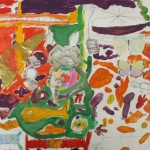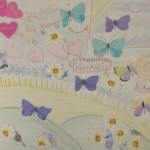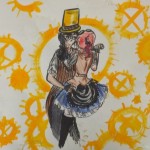
The Surrealism unit that I taught to the Grade 8 art class in Haida Gwaii was more difficult than I imagined. When I dreamt up the unit, I pictured it would be a great opportunity for the students to explore their own imagination and use their creative juices to come up with virtually anything.
Surrealism was an art movement during the 1920s-1930s that surfaced as a result of Dada- an anti-war movement that believed in the meaningless of life. Drawing from such radical beliefs, the Surrealists produced literary and visual works. One of the most well-known Surrealists is Salvador Dali, a Spanish artist. Dali was exceptional at tapping into the human psyche and putting these unconscious thoughts onto canvas. Primarily concerned with the notion of dreaming, many of the works produced by Surrealist artists appear to be fantastical, impossible, and ridiculous. Wanting to tap into my students’ imagination, I decided to take tis opportunity to create a mixed media project. I encountered several difficulties that I did not foresee.
1. Need more guidance (tapping into their own imagination and putting it onto a blank sheet of paper is more difficult than I thought)
2. The magazines that I brought out for the collaging aspects were taken advantage of; students would simply cut out images that they “liked” and said it represents them
3. Students had trouble focusing on a central theme. The project is indeed about themselves but something about them selecting random images that they liked did not sit well with me. I proceeded to show them my Surrealist project and how to focus their theme on one aspect of themselves
4. Surrealism and strict guidelines are inherently contradictory: Surrealism advocates “automatic” and “subconscious” thoughts. Limiting these “automatic” thoughts by enforcing project guidelines (I.e. One central theme) makes it easier for assessment but restricts the automatism and freedom that students should feel when making their art!!
These are some of the project obstacles that I encountered when working with this unit and with this grade level. At the very least, I have identified some of these major issues. The next time that I teach this unit, perhaps I will have to reassess how I evaluate their projects. Are rubrics possible for art projects let alone a Surrealist art project? I think focusing on one central theme is still important. I emphasized to the class that despite Dali’s “random” assortment of objects within one painting, he still chose THOSE objects over others; therefore, they are actually NOT random but are well thought out. Together, these seemingly misplaced and strange objects still tell a coherent narrative. Despite this, I have examples of my students’ work that I would like to share. I only had 3 classes with them so they are for the most part, unfinished. I believe that they will look wonderful when complete.















